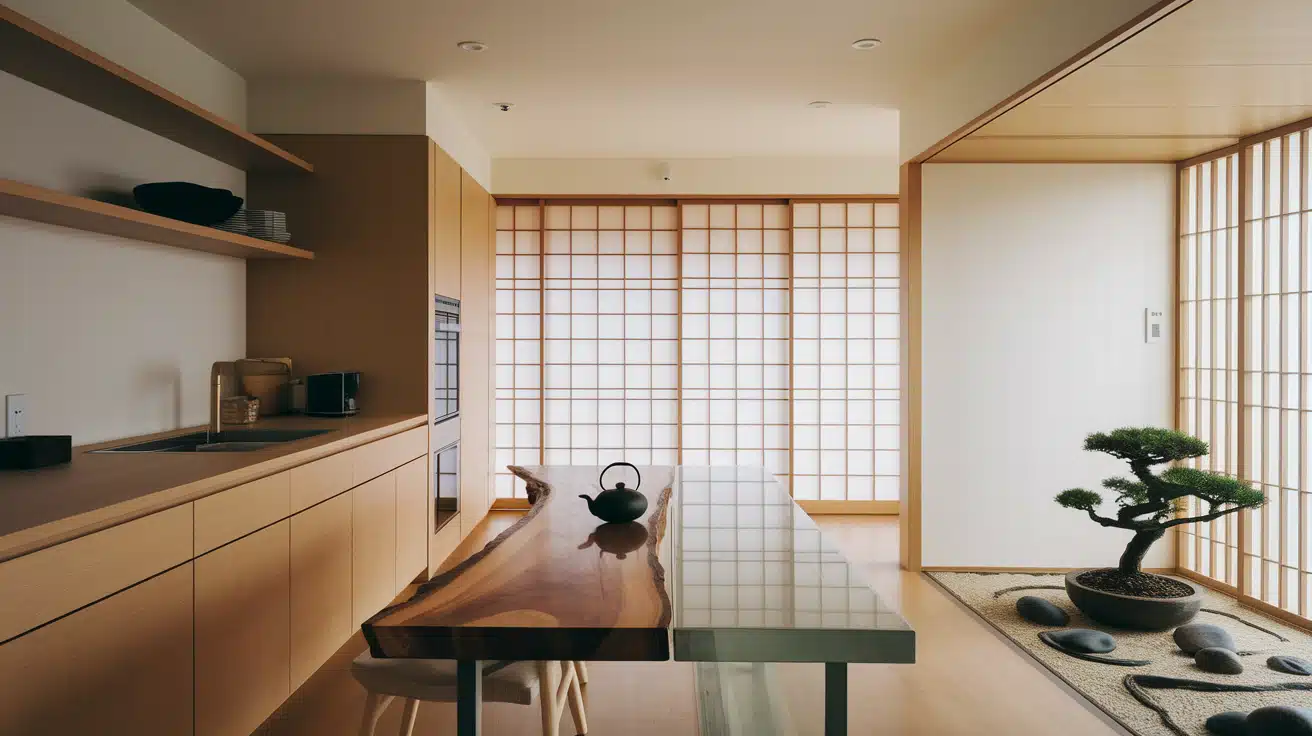After years of cooking in cramped, cluttered kitchens, I’ve realized the transformative power of Japanese design principles.
The clean lines, thoughtful organization, and natural elements create a space that feels both peaceful and practical.
My trip toward a more mindful cooking area began with small changes—swapping plastic for bamboo, clearing countertops, and prioritizing functional beauty.
Now, my kitchen isn’t just where I prepare meals; it’s where I find daily moments of calm amid life’s chaos.
If you’re yearning for a kitchen that balances efficiency with tranquility, Japanese design offers timeless inspiration worth exploring.
Why You Should Consider Redoing Your Kitchen with Japanese Inspiration?
Bringing Japanese design principles into your kitchen can transform your daily experience. The thoughtful approach to space creates both functionality and tranquility that’s hard to find in other styles.
- Simplicity and serenity become part of everyday life
- Space efficiency and smart storage solutions maximize even small kitchens
- Natural elements create harmony and balance in your cooking space
Japanese kitchens blend practicality with mindfulness. The clean lines and purposeful organization eliminate visual noise, while the emphasis on natural materials connects you to the environment.
This design philosophy creates a peaceful sanctuary where cooking becomes a meditative practice rather than just another chore.
Timeless Beauty of Japanese Kitchen Design
Learn how these stunning Japanese-inspired kitchens blend minimalism, natural elements, and thoughtful design to create spaces that are both beautiful and functional for everyday living.
1. Zen Minimalist Kitchen
The Zen minimalist kitchen embodies the essence of Japanese design philosophy. With clean lines, neutral colors (typically whites, beiges, and soft grays), and a deliberate absence of clutter, this kitchen style creates a sense of calm that permeates your cooking experience. Every element serves a purpose, with nothing unnecessary competing for attention.
Design tip: Keep countertops clear except for 1-2 beautiful functional items like a handmade ceramic tea set or a natural wood cutting board.
2. Natural Wood Accents
Wood is fundamental to Japanese design, bringing warmth and connection to nature. Kitchens featuring exposed wooden beams, cedar or cypress cabinetry, or statement wood paneling create an inviting atmosphere that feels both grounded and refined.
Design tip: Mix different wood tones but keep them in the same family—light to medium woods like hinoki (Japanese cypress), cedar, or maple work beautifully together.
3. Open Concept with Sliding Shoji Doors
Traditional shoji doors—translucent paper over a wooden frame—offer an elegant solution for dividing spaces while maintaining openness. These sliding partitions create flexible boundaries between kitchen and dining areas, allowing you to open the space completely or create intimate separation as needed.
Design tip: Modern versions can use frosted glass instead of paper for durability while maintaining the same ethereal light diffusion.
4. Compact and Clever
Japanese homes have mastered the art of making small spaces feel generous and functional. These kitchens feature ingenious storage solutions: pull-out pantries, multi-functional islands, and custom cabinetry that utilizes every vertical inch.
Design tip: Look upward—the space between cabinet tops and ceilings is valuable storage real estate for seasonal items.
5. Modern Meets Traditional
This fusion style balances sleek stainless steel appliances and contemporary fixtures with traditional Japanese elements like hand-planed wood surfaces or handmade ceramic tiles. The contrast creates a kitchen that feels timeless rather than trend-driven.
Design tip: Balance every modern element with something natural or handcrafted to maintain harmony.
6. Earthy Tones and Textures
Inspired by natural landscapes, these kitchens feature stone countertops, clay backsplashes, and matte finishes in colors reminiscent of earth, sand, and stone. The textural variety adds depth without busyness.
Design tip: Incorporate at least three different natural textures—perhaps stone, wood, and clay—to create visual interest without relying on bold colors.
7. Wabi-Sabi-Inspired Layout
Wabi-sabi embraces imperfection and transience. Kitchens designed with this philosophy might feature handmade ceramic tiles with slight variations, live-edge wood countertops, or patinated copper fixtures that will develop character over time.
Design tip: Choose at least one element that will age beautifully, developing a patina that tells the story of your kitchen’s life.
8. All-White Japanese Kitchen
A bright, white kitchen creates an airy canvas where subtle design elements can shine. These spaces emphasize light, with minimal ornamentation and carefully considered details like a single ikebana flower arrangement or handmade pottery collection.
Design tip: Add warmth to an all-white space with natural fiber textiles like a hand-loomed linen runner or cotton cushions.
9. Tatami-Inspired Flooring
Traditional tatami mats—made from woven rush grass—inspire kitchens with natural fiber flooring or geometric patterns that echo tatami arrangements. These floors bring texture and warmth to the foundation of your kitchen design.
Design tip: If authentic tatami is impractical for kitchen use, consider porcelain tiles with tatami-inspired textures and patterns in a durable, waterproof format.
10. Black and Wood Combo
The dramatic pairing of dark elements with natural wood creates a bold yet grounded palette that feels both contemporary and timeless. Matte black fixtures, appliances, or cabinetry contrasted with warm wood tones creates sophisticated tension.
Design tip: Keep the black elements matte rather than glossy for an authentic Japanese aesthetic.
11. Japanese-Scandinavian Fusion (Japandi)
This increasingly popular hybrid style combines Japanese minimalism with Scandinavian functionality and warmth. These kitchens feature clean lines and natural materials but add cozy elements like sheepskin chair covers or pendant lighting that creates intimate atmosphere.
Design tip: Focus on craftsmanship—both traditions value well-made, long-lasting items over disposable goods.
12. Tea Corner Integration
A dedicated space for tea preparation honors the Japanese tea ceremony tradition while creating a mindful pause in your kitchen routine. This might be as simple as a small counter area with essential tools or as elaborate as a custom tea preparation station.
Design tip: Select a location near natural light for your tea corner, ideally with a view of nature or a small indoor garden.
13. Indoor Zen Garden Element
Bringing elements of a zen garden indoors creates a meditative focal point in your kitchen. Small plant arrangements, carefully placed stones, or even miniature sand gardens can infuse daily cooking with contemplative beauty.
Design tip: Choose low-maintenance plants like bamboo or bonsai that require mindful care but won’t be damaged by kitchen humidity.
Common Mistakes to Avoid
- Over-decorating the space with too many decorative items contradicts the fundamental Japanese principle of minimalism. Less truly is more.
- Using too many bold colors instead of adopting a neutral palette with subtle natural accents. Vivid colors can disrupt the sense of calm.
- Ignoring natural lighting opportunities. Japanese design prizes natural light, so consider removing heavy window coverings that block sunlight.
- They forget functional flow, which is essential in Japanese kitchens. Each zone should transition smoothly to the next for intuitive cooking.
- Choosing the wrong materials like glossy, synthetic finishes instead of matte, natural textures that create an original atmosphere and connection to nature.
Alternate Ideas If You’re Not Ready for a Full Remodel
- Add wooden open shelving for an instant warmth boost and display space for carefully curated items.
- Swap out cabinet fronts with lighter wood or neutral tones. This single change can transform your kitchen’s entire feel.
- Incorporate minimalist Japanese dishware as both functional tools and beautiful decor.
- Use natural textiles like unbleached cotton or raw linen for window treatments and table runners.
- Add bamboo or shoji-style accents – even a simple bamboo mat or a divided screen can introduce authentic Japanese elements.
Conclusion
The beauty of Japanese kitchen design lies in its thoughtful balance of form and function.
As I’ve explored these principles in my own home, I’ve found that even small changes can shift not just how my kitchen looks but how it feels to spend time there.
Whether you embrace a complete renovation or simply incorporate a few elements that speak to you, the result is the same: a kitchen that invites presence rather than distraction.
In our fast-paced world, creating a space that encourages mindfulness and appreciation for simple moments might be the most valuable renovation of all.





















